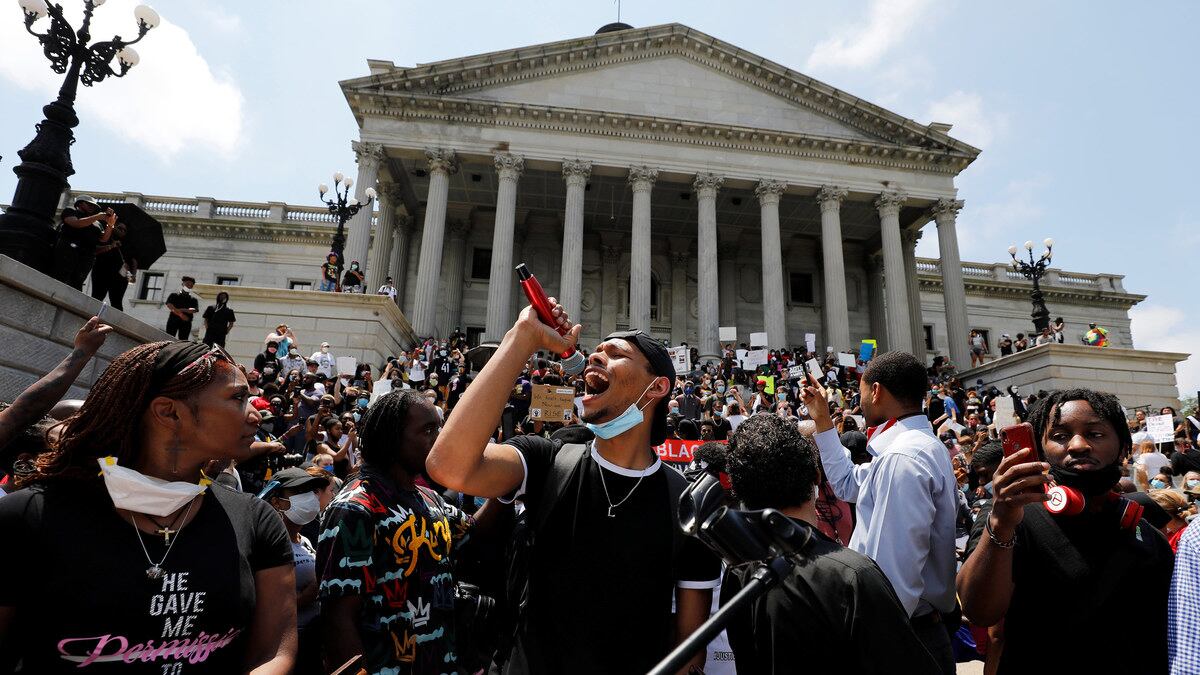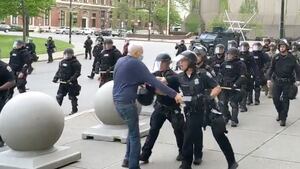COLUMBIA, South Carolina—Steve Benjamin, the black mayor of Columbia, was pissed.
“Take your asses home,” he ordered.
It was Saturday evening, May 30, in this city of 140,000. A day of protests over the killing of George Floyd by Minneapolis police had started peacefully. That afternoon, hundreds of people gathered at the state capitol building at the southern end of the city’s bustling Main Street.
They held signs. They chanted. They sang hymns. But they didn’t break any laws. Nothing burned.
What happened next maps onto the experiences of other, bigger cities across the United States. The demonstration escalated, and the police retaliated with disproportionate force. Opportunists responded with force of their own.
For a couple of days, parts of Columbia—a laid-back, liberal-by-Southern-standards college town, if also a state capital with a long history of Confederate symbolism—looked and felt like a war zone.
But local leaders prevented a deeper crisis. Protest organizers, politicians, and police met, talked, and de-escalated. They ejected alleged out-of-town instigators—the intended audience of Benjamin’s “take your asses home” comment, if also a vastly overhyped phenomenon. They tried, really tried, to quell extremists in their own ranks.
And the result, just days after Benjamin’s angry rant, was a sense of relative calm. The protesters were still protesting, but they weren’t breaking things. The cops were still arresting people, but they weren’t firing rubber bullets and tear gas anymore.
It seemed Columbia had struck some kind of balance—one that other communities might have sought to emulate as protests showed signs, at least for a while, of spinning out of control.
Last Tuesday, the potential for a resurgence of violence in Columbia remained high. It was hot. School was out and lots of young people were unemployed. The novel coronavirus, which in late May and early June was infecting around 300 South Carolinians a day, loomed over everything, lending the political conflict an apocalyptic vibe.
But for many people, the fear that hung in the air on that first Saturday and Sunday was gone.

That first Saturday afternoon, the temperature rose to 90 degrees and many of the protesters went home, leaving behind a few hundred of their youngest and angriest. The hard-core demonstrators—a mix of young black folks, Latino allies, white punk types and a few grizzled veterans of 1960s unrest—marched the half mile or so up Main Street and west toward the Congaree River.
They crowded the courtyard outside police headquarters. Officers formed a phalanx. The stand-off was tense but civil—and then all hell broke loose.
A few people in the crowd of protesters chased away a young white counter-protester. Other people among the demonstrators ferreted one cop out of his phalanx and lunged at him. He used pepper spray. According to multiple news reports, projectiles pummeled the police and they retreated, at least one of them injured.
Efforts by the vast majority of the protesters to calm a violent minority failed. The retreating police had abandoned several cruisers. Soon they were on fire.
Todd Rutherford, a black state lawmaker who had attended the main rally with his fiance and kids, hurried back downtown and found the police cruisers burning. He begged the police reinforcements not to push the protesters into the surrounding commercial districts. But Rutherford said the advancing cops ignored his plea. (The police department said it could not confirm Rutherford’s claim. “Our officers had numerous encounters with citizens that day and we have not been made aware of Rep. Rutherford’s claim by officers,” police spokesperson Jennifer Timmons told The Daily Beast.)
Hundreds of protesters streamed outward. Rioters appear to have knocked out a white kid after he threatened to call the police. They shattered the windows of several local shops and set fires.
Rutherford said he noticed signs and graffiti with out-of-town associations—evidence, he said, that outsiders had infiltrated the demonstration, a hotly contested and often dubious claim made by law enforcement about rogue agitators in recent days. He said he saw rioters try to break into a jewelry store. Blocked by the store’s security gate, vandals moved one store down and broke the windows, and one business owner stood outside his own shop, begging for the rioters to spare his place, Rutherford recalled.
Police appeared, sending the demonstrators fleeing farther afield. From afar, Columbia looked like a battlefield. Smoke curling into the sky. Sirens blaring. Helicopters circling overhead. People running and shouting.

Organizer Lawrence Nathaniel speaks at a recent Columbia, S.C., protest
David AxeThat’s when Benjamin, the mayor, stood at a podium at city hall and announced a curfew starting at 6 p.m. that day. “When protests go from being peaceful to being violent, the situation changes... and this won’t be tolerated,” Benjamin said. “We’re going to shut it down and shut it down right now.”
As for any out-of-towners—well, Benjamin made it clear where they should take their asses.
It was a long night for protesters and police alike. Someone fired a gun. If he was aiming at the cops, he missed. Officers gave chase and arrested him. In all, police made more than a dozen arrests that night. Four of their own were injured, one seriously when he was struck by a brick. A firefighter was also hurt.
The next day was tense. A pair of helicopters took turns patrolling over the city. Cops from all over the state, including a squad of state corrections department riot-busters in red jumpsuits, crowded into the main police compound to take their orders from Columbia police chief Skip Holbrook and Richland County Sheriff Leon Lott. The city broke out its bright blue, Army-surplus Mine-Resistant Ambush-Protected armored vehicle, which had spent years parked near the local recycling center.
Protesters, led in part by a young black political candidate and former Bernie Sanders staffer named Lawrence Nathaniel, gathered near the capitol building. “This is about love,” Demetris Hill, another black protest-organizer, told The Daily Beast.
But that love met an army of resistance. The police, most of them white, fired nonlethal rounds, injuring several protesters. Tear gas canisters clattered on the asphalt. People ran—some to escape the spreading haze of gas, others to seek emergency medical assistance at a makeshift aid station that a man named Mason Crowson had set up in his wine bar The Aristocrat.
Nathaniel told The Post and Courier newspaper he lost control of the demonstrators. “I feel like it’s on me.”
Benjamin ordered another curfew. Lott and Holbrook walked the debris-strewn streets behind walls of armored policemen. As a police drone buzzed overhead, they swept the downtown neighborhoods and arrested another 30 or so people, including a man from a nearby town named Dominic Gladden.
In Gladden's backpack, authorities found a pistol and 70 rounds of ammunition. Gladden insisted he had no plan to harm anyone.
Day two was worse than day one. But on day three, the fever seemed to break—at least temporarily. Conversation apparently made the difference. Nathaniel spoke to police leaders and Benjamin, presenting them his group’s list of demands.
The list included mandatory mental-health evaluations for all officers assigned to minority communities and the creation of a civilian review board to oversee police conduct.
Nathaniel told The Daily Beast that Holbrook, Lott and Benjamin agreed to discuss the reforms. “We got our demands,” he said.
Benjamin told The Daily Beast talks would begin as soon as the pandemic eased and it was safe to gather indoors.
When around 200 protesters returned to the capitol last Monday afternoon, Nathaniel had his megaphone practically glued to his lips. He seemed determined not to lose control again. Benjamin met the protesters, sat with them, and talked. He stayed out there for more than an hour, only occasionally dodging into the shade to escape the sun.
The protests were calmer. Nathaniel led a procession to a nearby memorial for African-American veterans. Demonstrators sang hymns. Around 4 p.m., Nathaniel declared the protest over and urged everyone to leave. “Be revolutionaries from home,” he said. Nathaniel’s group planned to spend the next day administering free coronavirus tests and giving away haircuts to job-seekers.
Nathaniel went home. Most of his fellow protesters did not. But they didn’t riot. And the roughly 50 police who lingered on the edges of the capitol grounds didn’t attack them. Twice, state troopers darted into the crowd to arrest volunteer medics on charges of inciting violence—charges that the demonstrators insisted were bogus.
The arrests elicited howls of rage from the crowd. But no one fought. No tear gas canisters flew. When night fell and curfew came, everyone went home.
“People are frustrated,” Rutherford said. “They want to know that they have an ear.” Benjamin, Lott, and Holbrook chose to lend that ear rather than further escalate a dangerous situation.
And they backed up their willingness to listen with at least something resembling action. After social media users identified a white man who had apparently joined the protest group in order to vandalize local businesses, Lott swiftly responded. “He’ll be getting a knock on his door,” he tweeted.
After claims from activists that a Columbia police officer pressed his knee against the neck of a protester while arresting him on May 30, Benjamin found and released police bodycam footage depicting the arrest. The footage appears to confirm that the arresting officer kneeled on the protester’s neck, a tactic Benjamin said was prohibited in Columbia.
“The chokehold is not allowed under city of Columbia policies and will not be tolerated,” Benjamin said in a statement. “I immediately spoke with Chief Holbrook, who was aware of the situation and had already conducted a full review of the situation and also a review of our policies.”

Columbia Mayor Steve Benjamin speaks with protesters
David AxeHill, the protest organizer, explained that progress, not protest, was the point. “Our demands have been heard,” she told The Daily Beast. “Now we’re going to think about how to infiltrate the system and bring it down in a loving and peaceful way.”
Peaceful protests continued in Columbia throughout this past week. There were no arrests at the rallies, although police did arrest several men with alleged right-wing ties that authorities suspected were involved in instigating violence during the initial clashes.
On Thursday, protesters marched to police headquarters. On Friday, hundreds of demonstrators led by Nathaniel gathered at the mansion of Gov. Henry McMaster. As state agents peered at them over the mansion walls, the demonstrators read a list of additional demands.
They wanted reforms to the state’s freedom of information laws, stricter requirements regarding police body-cams, more racial-sensitivity training for police—and an end to state and local acquisition of military equipment for law-enforcement purposes. There are, of course, far more radical demands out there, including calls to defund, dismantle, and abolish police departments.
But in Columbia, the protesters repeated their demands on the capitol steps, and Rutherford was there to receive them.
Asked if he agreed with the list, Rutherford smiled.
“It should be longer,” he said.






